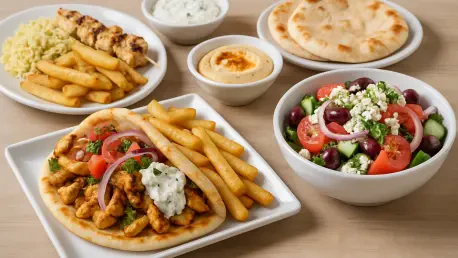Imagine stepping into a bustling urban eatery where the tantalizing aroma of grilled souvlaki and freshly baked pita fills the air, blending the vibrant flavors of the Mediterranean with the speed and convenience of modern dining. This vivid scene is becoming increasingly common as fast-casual Greek cuisine surges in popularity across the United States. The trend reflects a broader shift in consumer preferences toward authentic, ethnic foods that offer both bold tastes and quick service. This analysis delves into the remarkable growth of this sector, exploring market dynamics, standout success stories, key drivers behind the boom, expert perspectives, and a forward-looking view on what lies ahead for this flavorful dining niche.
The Rise of Fast-Casual Greek Cuisine
Market Growth and Consumer Demand
The fast-casual Greek dining sector is experiencing a significant upswing, fueled by a growing appetite for diverse and fresh culinary options. Recent industry data indicates that the fast-casual segment, particularly ethnic cuisine, has seen double-digit growth over recent years, with Greek food carving out a notable share due to its appeal as a healthier, flavor-packed alternative to traditional fast food. Reports highlight that consumer demand for Mediterranean-inspired dishes has risen sharply, with many citing a preference for meals that balance taste with nutritional value.
This trend is not merely a passing fad but part of a larger movement toward cultural exploration through food. The accessibility of Greek cuisine in a fast-casual format caters to busy lifestyles, making it a go-to choice for urban dwellers and suburban families alike. Market analysts note that the sector’s expansion is driven by an increasing number of diners seeking quick yet authentic dining experiences that stand out from mainstream offerings.
Moreover, the rise in health-conscious eating habits has positioned Greek cuisine favorably, as its emphasis on olive oil, fresh vegetables, and lean proteins aligns with current dietary trends. This alignment has helped propel the category into the spotlight, with projections suggesting sustained growth as more consumers prioritize both convenience and quality in their meal choices.
Real-World Success Stories
A prime example of this trend’s momentum is the rapid expansion of Nick the Greek, a fast-casual chain specializing in authentic Greek street food. As of this year, the brand has surpassed 85 locations nationwide, with an ambitious plan to exceed 100 by the end of the current period. This growth trajectory showcases the scalability of Greek cuisine within the fast-casual model, capturing a wide audience with its approachable yet distinctive menu.
Nick the Greek has strategically targeted high-growth markets such as Orange County, Houston, and Phoenix for new openings, tapping into diverse demographics and urban centers hungry for novel dining options. These locations have not only increased the brand’s visibility but also demonstrated the universal appeal of Greek flavors, from gyros to salads, in varied regional contexts. The upcoming debut in Nashville further signals an intent to penetrate new territories with confidence.
Beyond mere expansion, the chain has driven sales through innovative menu additions like the Mediterranean Bowl and Pistachio Cream “Dubai Chocolate” Froyo, which have resonated strongly with customers. These items have led to significant upticks in specific product categories, reinforcing how menu creativity can fuel growth while maintaining cultural authenticity. Such achievements highlight the practical impact of this trend on the ground.
Key Drivers and Industry Validation
The surge in fast-casual Greek cuisine is underpinned by several critical factors, including a strong consumer push for ethnic diversity in dining and the operational agility of brands to meet this demand. Industry leaders point to a mission-driven approach as a key differentiator, with Komiel Mohsen, Chief Operating Officer at Nick the Greek, emphasizing the goal of showing communities that the best things in life are rooted in Greek heritage. This vision has helped position the brand as a cultural ambassador within the fast-casual space.
Validation from industry accolades further solidifies the credibility of this trend. Recognition such as a debut at #385 on Entrepreneur’s Franchise 500® list and a ranking of #75 on Fast Casual’s Top 100 Movers & Shakers underscores the growing prominence of Greek concepts among peers. These honors reflect not just consumer appeal but also operational excellence and franchise potential, drawing attention from investors and entrepreneurs alike.
Additionally, the ability to balance rapid scaling with quality control stands as a pivotal driver. As brands expand, maintaining the integrity of traditional recipes while adapting to local tastes has proven essential. This balance, coupled with a strategic focus on franchise development, ensures that the trend gains traction among business operators looking to capitalize on a proven and profitable model.
Future Prospects for Greek Fast-Casual Dining
Looking ahead, the fast-casual Greek cuisine sector appears poised for continued expansion, with opportunities for franchise growth into untapped markets across the country. Emerging regions with diverse populations and a penchant for culinary variety present fertile ground for new locations, potentially broadening the reach of Greek street food to smaller cities and towns. This geographic diversification could further democratize access to authentic ethnic flavors.
Menu innovation remains a critical area for future development, as brands are likely to experiment with new offerings that cater to evolving consumer preferences, such as plant-based options or fusion dishes. However, challenges loom, including the need to preserve quality during rapid growth and to stand out amid competition from other fast-casual ethnic niches. Navigating these hurdles will require a keen focus on consistency and brand differentiation.
The broader implications of this trend extend beyond Greek cuisine itself, potentially inspiring other ethnic food categories to gain similar traction in the fast-casual arena. As diners become more adventurous, this could reshape the dining landscape, encouraging a wave of cultural representation through food. Such shifts might redefine how Americans engage with global cuisines, fostering a more inclusive culinary environment over time.
Conclusion: Embracing the Greek Dining Wave
Reflecting on the trajectory of fast-casual Greek cuisine, the sector has demonstrated robust growth, with standout performances from brands like Nick the Greek setting a high bar for success. Key drivers such as consumer demand for authenticity and strategic innovation have played a pivotal role in elevating this niche within the competitive dining market. Industry validations through prestigious rankings have further cemented its place as a formidable force.
Moving forward, stakeholders and enthusiasts alike should consider exploring local Greek eateries to experience this dynamic trend firsthand. For those in the business realm, evaluating investment opportunities in this rising market could yield significant returns, given the proven demand and scalability. As the landscape continues to evolve, staying attuned to consumer shifts and supporting authentic culinary ventures will be essential to sustaining this flavorful wave for years to come.









